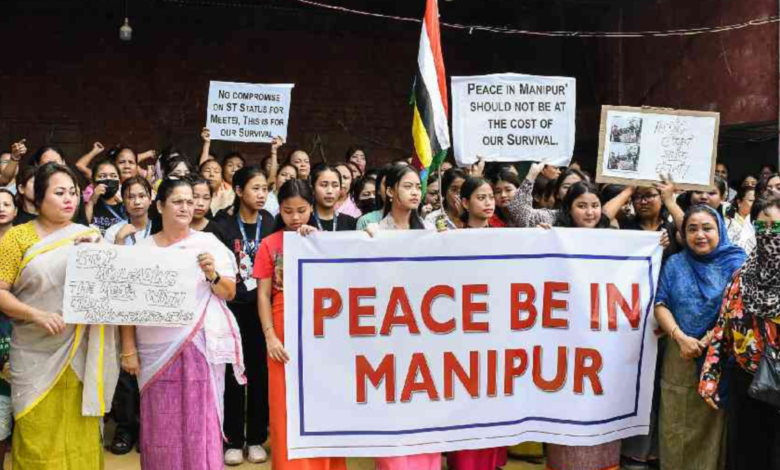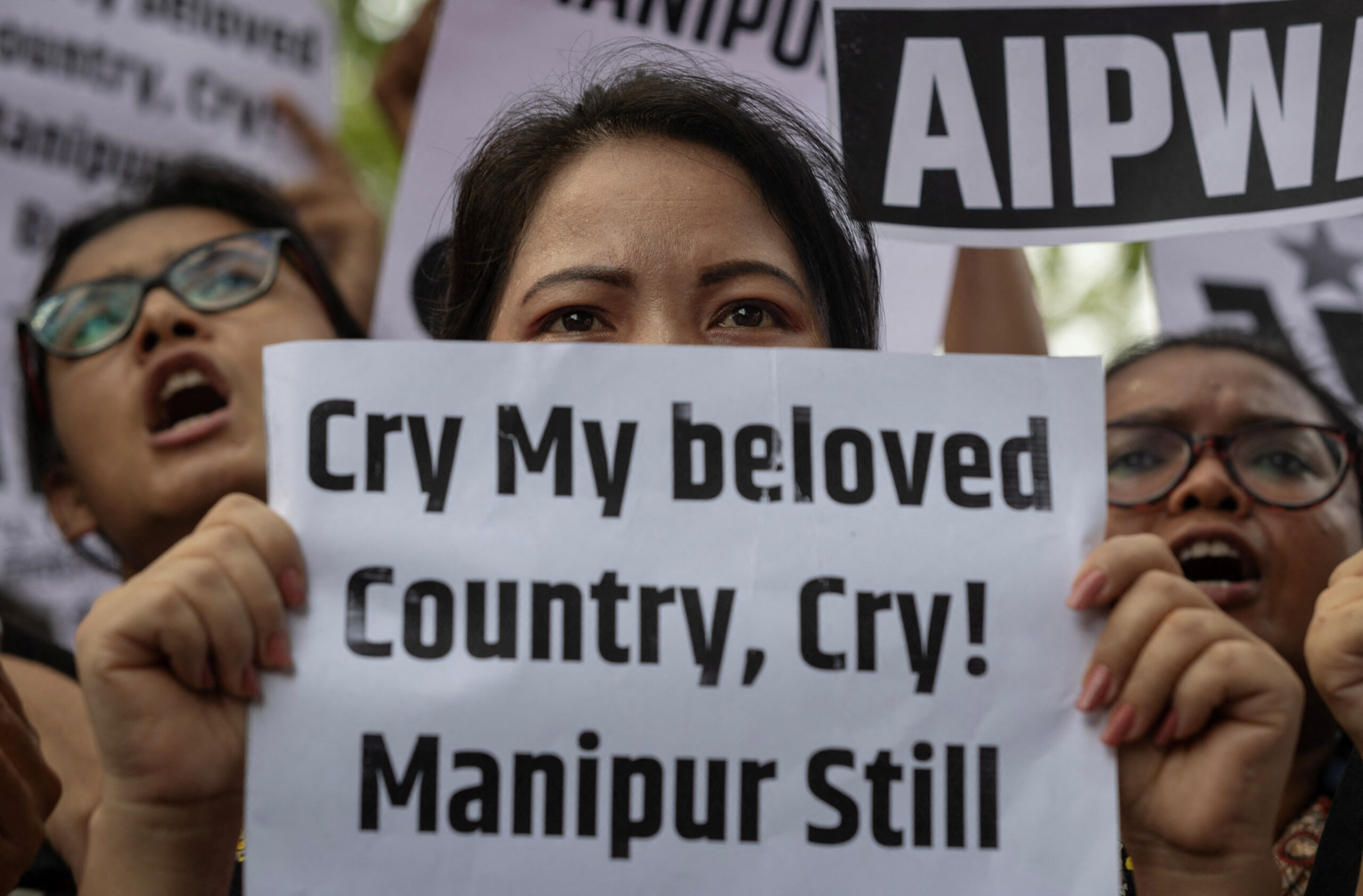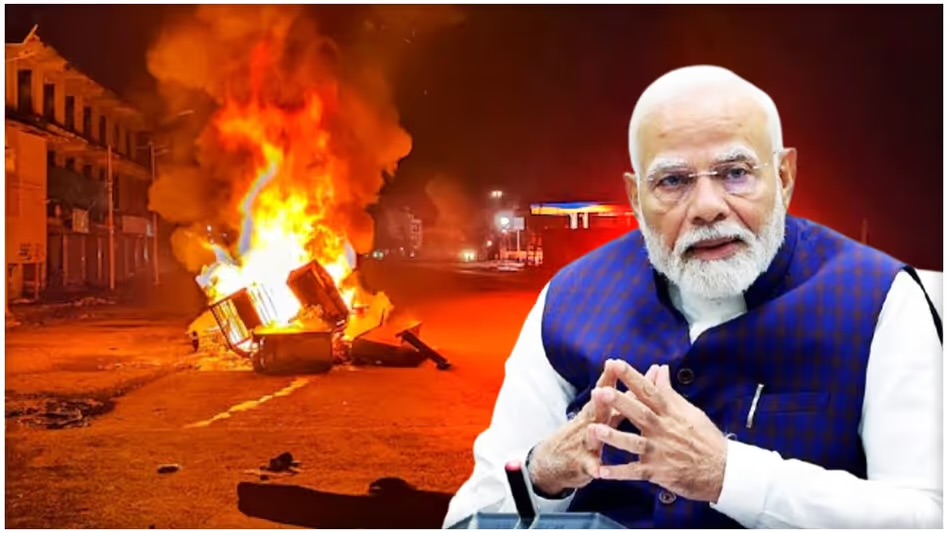Manipur’s Ethnic Crisis; A State Torn Apart by Long-standing Hatreds. Will The Government’s Silence Continue to Feed the Flames?
Since May 3, 2023, the northeastern state of Manipur, India, has been stuck in a violent fight between two major groups. The Meitei community, who mostly live in the Imphal Valley, and the Kuki-Zo tribes, who live in the hill areas, are fighting each other. What started as a local issue has turned into a deadly conflict, killing nearly 250 people, forcing thousands to leave their homes, and causing big economic damage. However, the causes of this conflict go back many years, due to historical, geographical, and political reasons.

Since May 3, 2023, the northeastern state of Manipur, India, has been trapped in a violent ethnic conflict. This conflict has pitted two major communities against each other, the Meitei community, which lives mainly in the Imphal Valley, and the Kuki-Zo tribes, who inhabit the hilly regions of the state.
What was once a regional dispute has now blown up into a bloody war, taking almost 250 lives, displacing thousands of people, and causing immense economic losses. However, the roots of this conflict go far back in time, brewing for many years because of historical, geographical, and political reasons.
Long-standing tensions between these two communities and how the state and central governments have handled or failed to handle the situation are essential to understanding the current crisis.
Historical Background
This is not a new tension between the Meiteis and the Kukis; tensions date back to times even before India gained independence in 1947. The Meiteis are the dominant group, the majority of the population, and enjoy better political clout. The Kuki-Zo tribes and some other indigenous tribes reside primarily in the central valley of Manipur, on the other side, in the hills surrounding the valley.
While the Meiteis follow Hinduism, the Kukis, and Nagas, the other tribal group in the region, follow Christianity. These religious differences, added to geographical separations, make it difficult for these communities to live harmoniously.
The geography of Manipur adds to this divide. About 10% of the land the state possesses is taken over by the valley, where all the significant populations of Meiteis reside, and the remaining hills with 90% are found to be inhabiting Kuki-Zo and other tribal populations. While their land may be much larger, the Kukis’ population and the other tribe members comprise a far smaller portion. An imbalance has repeatedly contributed to friction over land rights, resources, and political representation, among others.
What motivated the violence this year?

The immediate cause of the crisis in 2023 was that of a court order. On April 19, 2023, the Manipur High Court issued an order to grant Scheduled Tribe status to the Meitei community. ST status in India gives reserved seats in educational institutions and government jobs and special protections for land ownership among others.
Strong opposition to this decision came from the Kuki-Zo tribes. They feel that once the Meiteis acquire ST status, they can buy land in the hills reserved for tribal communities of the state. Their insecurity led to protests, quickly escalating into violent clashes between the two groups.
Violence struck first in the district of Churachandpur, mainly populated by the Kukis, and spread throughout the state. Within the first couple of days alone, several people had been killed, homes reduced to ashes, and thousands displaced from their communities.
Political Failures and Government Response
With violence spiralling, many blamed the silence of the central government under Prime Minister Narendra Modi and its inaction. Many even faulted the state government under Chief Minister N. Biren Singh for failure to arrest the situation.
The central government did deploy security forces in the area, but they were unable to put an end to the fights. Accusations were there that the security forces, most notably the Assam Rifles, were taking sides in this conflict. The Meitei community said that they were protecting the Kuki militants and the Kukis said that the security forces were well in favour of the Meiteis.
The Modi government maintained silence over the growing violence.
As critics would point out, this was a political game, the Centre did not want to intervene to not antagonise either community, with more elections around the corner.
Impact of the Conflict on the People of Manipur
The unabated violence has dealt a severe blow to the people of Manipur. More than 60,000 people were forced to flee their homes and have been living in relief camps with hardly any access to food, clean water, and health care. Whole villages have been reduced to ashes, with families torn asunder.
The state has also suffered economically, with businesses shut down and the state’s infrastructure badly damaged. The estimated losses due to this conflict run into many thousands of crores of rupees.
A series of reports say that civilians are getting targeted, including women and children. Disturbing incidents of sexual violence have taken place in which Meitei women and Kuki women have both become targets. One highly condemnable incident was where two Kuki women were paraded naked in public, sending shockwaves across the entire country.
Despite all these atrocities, the mainstream media in India has mostly remained silent about the happenings in Manipur. Accusations have mounted that the media has not made sufficient noise about this conflict, citing that it’s way out in a corner, so it doesn’t matter to India’s political and economic centers.
Drone Warfare
The use of drones in the conflict has made the situation grim. Reports started filtering in September 2023 that drones were deployed to drop bombs on rival communities, a dangerous escalation in the violence.
Whereas earlier, drones were used to keep watch, now they come as weapons. Such involvement is not joint in the internal conflicts of India, so the situation in Manipur is unique and very concerning..
The use of such high-tech instruments in a civil war suggests that the insurgent groups and militants are getting increasingly organised and better equipped in the region. At times, the militants among the Kukis have been accused of having hauled RPGs and other advanced firearms against the Meiteis.
This level of militarization among the civilian population is a rare sight in independent India, and it seriously jeopardises the stability of the region.
A Divided Manipur

Manipur is a divided state today: the Imphal Valley, dominated by the Meiteis, is pitted against the Kuki-dominated hill districts. Sandwiched between the two is a sort of “no-man’s land,” a vast six-kilometre stretch, a buffer zone highly militarized and patrolled by central security forces.
Thus, the buffer zone is a slush of security checks that anyone traveling from the valley to the hills or vice-versa must go through. It is pretty similar to other parts of the world that are in a state of heavy division, such as that of North and South Korea or the Line of Control between India and Pakistan in Kashmir.
This division has made access in one’s state quite harrowing. In some instances, people crossed into the wrong territory and got killed. Two Meitei students were killed last year after they had crossed the buffer zone by mistake. More recently, a former Indian Army soldier was killed for the same reason.
This is the first time such a division has taken place in India at this level, and it serves as a grim reminder of how deep the split in Manipur has run.
Insurgent Groups Playing Their Part
Another cause for concern in this conflict is the increasing clout of insurgent groups. Manipur has a long history of insurgency, with various groups fighting for independence or greater autonomy from India.
In recent years, however, most of these forces had been contained, and relative peace had reigned in the area. The present conflict, however, has given these insurgent groups a new lease on life.
Both the Meiteis and the Kukis have their own set of armed factions. Within the Meiteis themselves, groups like the Arambai Tenggol have cropped up as formidable forces; they have been accused of extortion, abduction, and even compelling local politicians to go through meetings with veiled threats of violence.
In return, the Kuki militants became more organized and well-equipped with sophisticated guns, even child soldiers, against the rival communities. The recent upsurge in militancy has only raised the risk and added to the situation’s complexity.
What Happens Next?
The Manipur conflict, therefore, has dragged on for 16 months with no end in sight. The Centre has tried some confidence-building measures, like the constitution of a peace committee headed by Union Home Minister Amit Shah. That, however, went nowhere because the state’s Chief Minister, Biren Singh -an incumbent perceived as highly divisive – was a member of that committee.
The demand for President’s Rule in the state – in effect abolishing the state government and bringing Manipur directly under central rule – has been raised by many. But even as the violence escalated, the Modi government did not favor such a move.
On their part, Kukis have started pressing for greater autonomy from the state government, with a few even demanding a separate administration under the central government. The Meiteis, on the other hand, are wholeheartedly opposed to the division of the state because this would threaten the territorial integrity of Manipur.
The Failure of Leadership

The crisis has at the heart a leadership failure at both the state and central levels. Chief Minister Biren Singh has been accused of fumbling with the situation and not acting effectively to quell the violence.
Meanwhile, the silence from the head of the central government, Prime Minister Narendra Modi, has been interpreted by many as a failure of the latter to tackle a severe internal security crisis. His critics feel that Modi’s greater preoccupation with international issues, like the war in Ukraine, has come at the cost of tackling significant internal problems like the war in Manipur.
According to many security experts, the overall situation in Manipur resembles a civil war. The level of violence, the use of sophisticated weaponry, and the sharp ethnic dividing lines indeed make this conflict one of the most severe internal crises Independent India has confronted.
India has been embroiled in several internal conflicts. Still, those incidents in Kashmir and northeast states were never Manipur-like because this was, all over, a different kind of large-scale violence between two ethnic communities within the same state.
Viewpoint
What, then, is the solution to this crisis? The first step would be to bring both sides to the negotiating table. This is easier said than done, considering the mutual distrust between the Meiteis and Kukis.
Another effective measure could be the more active intervention of the Centre in mediating the conflict. It could even go to the extent of sacking Chief Minister Biren Singh and placing the state under the President’s Rule to ensure a return to the rule of law.
In the long run, much will have to be done to prevent the root causes of this conflict: inequality, disputes over land, and lack of political representation. Unless these underlying problems are sorted out, Manipur can only dream of lasting peace.
The tragedy that is Manipur is a sad example of how ethnic divisions, past grievances, and political failures can tear society asunder. Be the situation ever so complex, what would quickly appear crystal clear to anyone is the dire need to halt the violence, come what may, and start the reconciliation process.
This happened in Manipur, the state has bled enough, and it is now the state’s and central governments’ turn to bring peace to the area. However, a solution will not be easy, as both sides are deeply entrenched. However, for the sake of the tens of thousands who lost homes, loved ones, and livelihoods, it is a challenge that must be faced.




